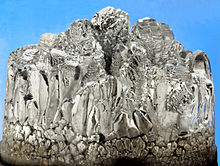
Back Magnesium Afrikaans ማግኒዥየም Amharic Magnesio AN मैग्नीशियम ANP مغنيسيوم Arabic ماݣنيزيوم ARY مغنسيوم ARZ Magnesiu AST म्याग्नेजियम AWA Maqnezium Azerbaijani
 | ||||||||||||||||||||||||||
| Magnesium | ||||||||||||||||||||||||||
|---|---|---|---|---|---|---|---|---|---|---|---|---|---|---|---|---|---|---|---|---|---|---|---|---|---|---|
| Pronunciation | /mæɡˈniːziəm/ | |||||||||||||||||||||||||
| Appearance | shiny grey solid | |||||||||||||||||||||||||
| Standard atomic weight Ar°(Mg) | ||||||||||||||||||||||||||
| [24.304, 24.307][1] | ||||||||||||||||||||||||||
| Magnesium in the periodic table | ||||||||||||||||||||||||||
| ||||||||||||||||||||||||||
| Group | group 2 (alkaline earth metals) | |||||||||||||||||||||||||
| Period | period 3 | |||||||||||||||||||||||||
| Block | s-block | |||||||||||||||||||||||||
| Electron configuration | [Ne] 3s2 | |||||||||||||||||||||||||
| Electrons per shell | 2, 8, 2 | |||||||||||||||||||||||||
| Physical properties | ||||||||||||||||||||||||||
| Phase at STP | solid | |||||||||||||||||||||||||
| Melting point | 923 K (650 °C, 1202 °F) | |||||||||||||||||||||||||
| Boiling point | 1363 K (1091 °C, 1994 °F) | |||||||||||||||||||||||||
| Density (near r.t.) | 1.738 g/cm3 | |||||||||||||||||||||||||
| when liquid (at m.p.) | 1.584 g/cm3 | |||||||||||||||||||||||||
| Heat of fusion | 8.48 kJ/mol | |||||||||||||||||||||||||
| Heat of vaporization | 128 kJ/mol | |||||||||||||||||||||||||
| Molar heat capacity | 24.869 J/(mol·K) | |||||||||||||||||||||||||
Vapor pressure
| ||||||||||||||||||||||||||
| Atomic properties | ||||||||||||||||||||||||||
| Oxidation states | 0,[2] +1,[3] +2 (a strongly basic oxide) | |||||||||||||||||||||||||
| Electronegativity | Pauling scale: 1.31 | |||||||||||||||||||||||||
| Ionization energies |
| |||||||||||||||||||||||||
| Atomic radius | empirical: 160 pm | |||||||||||||||||||||||||
| Covalent radius | 141±7 pm | |||||||||||||||||||||||||
| Van der Waals radius | 173 pm | |||||||||||||||||||||||||
| Other properties | ||||||||||||||||||||||||||
| Natural occurrence | primordial | |||||||||||||||||||||||||
| Crystal structure | hexagonal close-packed (hcp) | |||||||||||||||||||||||||
| Speed of sound thin rod | 4940 m/s (at r.t.) (annealed) | |||||||||||||||||||||||||
| Thermal expansion | 24.8 µm/(m⋅K) (at 25 °C) | |||||||||||||||||||||||||
| Thermal conductivity | 156 W/(m⋅K) | |||||||||||||||||||||||||
| Electrical resistivity | 43.9 nΩ⋅m (at 20 °C) | |||||||||||||||||||||||||
| Magnetic ordering | paramagnetic | |||||||||||||||||||||||||
| Molar magnetic susceptibility | +13.1·10−6 cm3/mol (298 K)[4] | |||||||||||||||||||||||||
| Young's modulus | 45 GPa | |||||||||||||||||||||||||
| Shear modulus | 17 GPa | |||||||||||||||||||||||||
| Bulk modulus | 35.4[5] GPa | |||||||||||||||||||||||||
| Poisson ratio | 0.290 | |||||||||||||||||||||||||
| Mohs hardness | 1–2.5 | |||||||||||||||||||||||||
| Brinell hardness | 44–260 MPa | |||||||||||||||||||||||||
| CAS Number | 7439-95-4 | |||||||||||||||||||||||||
| History | ||||||||||||||||||||||||||
| Naming | after Magnesia, Greece | |||||||||||||||||||||||||
| Discovery | Joseph Black (1755) | |||||||||||||||||||||||||
| First isolation | Humphry Davy (1808) | |||||||||||||||||||||||||
| Isotopes of magnesium | ||||||||||||||||||||||||||
| ||||||||||||||||||||||||||

Magnesium ( /mæɡˈniːziəm/ mag-NEE-zee-əm) is a chemical element. It has the symbol Mg, atomic number 12 and common oxidation state +2. It is an alkaline earth metal and the eighth most abundant element in the Earth's crust. It makes up 2% of the mass of the crust. It is the ninth most common element in the known universe.[8] This is because it is easily built up in supernova stars by addition of three helium nuclei to carbon (which in turn is made from three helium nuclei). Magnesium ion's high solubility in water helps ensure that it is the third most abundant element dissolved in seawater.[9]
Magnesium is the 11th most abundant element by mass in the human body. Its ions are essential to all living cells. The ions play a major role in manipulating important biological polyphosphate compounds like ATP, DNA, and RNA. Hundreds of enzymes thus require magnesium ions to function. Magnesium is also the metallic ion at the center of chlorophyll. It is a common additive to fertilizers.[10] Magnesium ions are sour to the taste, and in low concentrations help to impart a natural tartness to fresh mineral waters.
The free element (metal) is not found naturally on Earth, as it is highly reactive (though once produced, it is coated in a thin layer of oxide (see passivation), which partly masks this reactivity). The free metal burns with a brilliant white light, making it a useful ingredient in flares. The metal is now mainly obtained by electrolysis of magnesium salts obtained from brine.
- ↑ "Standard Atomic Weights: Magnesium". CIAAW. 2011.
- ↑ Mg(0) has been synthesized in a compound containing a Na2Mg22+ cluster coordinated to a bulky organic ligand; see Rösch, B.; Gentner, T. X.; Eyselein, J.; Langer, J.; Elsen, H.; Li, W.; Harder, S. (2021). "Strongly reducing magnesium(0) complexes". Nature. 592 (7856): 717–721. Bibcode:2021Natur.592..717R. doi:10.1038/s41586-021-03401-w. PMID 33911274. S2CID 233447380
- ↑ Bernath, P. F.; Black, J. H. & Brault, J. W. (1985). "The spectrum of magnesium hydride" (PDF). Astrophysical Journal. 298: 375. Bibcode:1985ApJ...298..375B. doi:10.1086/163620.. See also Low valent magnesium compounds.
- ↑ Weast, Robert (1984). CRC, Handbook of Chemistry and Physics. Boca Raton, Florida: Chemical Rubber Company Publishing. pp. E110. ISBN 0-8493-0464-4.
- ↑ K. A. Gschneider, Solid State Phys. 16, 308 (1964)
- ↑ Kondev, F. G.; Wang, M.; Huang, W. J.; Naimi, S.; Audi, G. (2021). "The NUBASE2020 evaluation of nuclear properties" (PDF). Chinese Physics C. 45 (3): 030001. doi:10.1088/1674-1137/abddae.
- ↑ Bernath, P. F.; Black, J. H.; Brault, J. W. (1985). "The spectrum of magnesium hydride" (PDF). Astrophysical Journal. 298: 375. Bibcode:1985ApJ...298..375B. doi:10.1086/163620.
- ↑ Ash, Russell (2005). The Top 10 of Everything 2006: The Ultimate Book of Lists. Dk Pub. ISBN 0756613213. Archived from the original on 2010-02-10. Retrieved 2011-09-26..
- ↑ Anthoni, J Floor (2006). "The chemical composition of seawater".
- ↑ "Magnesium in health".
